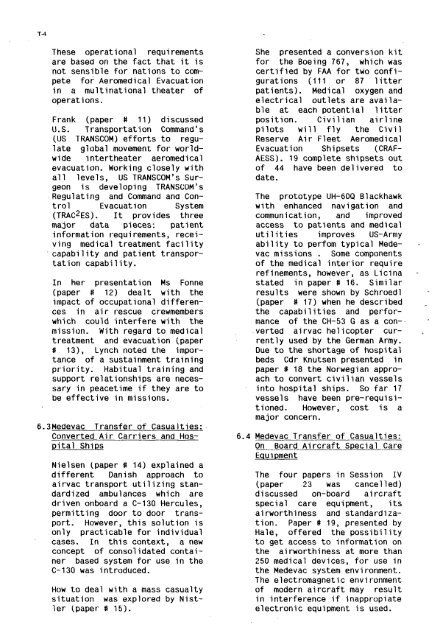Recent Issues and Advances in Aeromedical Evacuation (MEDEVAC)
Recent Issues and Advances in Aeromedical Evacuation (MEDEVAC)
Recent Issues and Advances in Aeromedical Evacuation (MEDEVAC)
Create successful ePaper yourself
Turn your PDF publications into a flip-book with our unique Google optimized e-Paper software.
T-4<br />
These operational requirements<br />
are based on the fact that it is<br />
not sensible for nations to com-<br />
pete for <strong>Aeromedical</strong> <strong>Evacuation</strong><br />
<strong>in</strong> a mult<strong>in</strong>ational theater of<br />
operat ions.<br />
Frank (paper # 11) discussed<br />
U.S. Transportation Comm<strong>and</strong>’s<br />
(US TRANSCOM) efforts to regu-<br />
late global movement for world-<br />
wide <strong>in</strong>tertheater aeromedical<br />
evacuation. Work<strong>in</strong>g closely with<br />
all levels, US TRANSCOM’s Sur-<br />
geon is develop<strong>in</strong>g TRANSCOM’s<br />
Regulat<strong>in</strong>g <strong>and</strong> Comm<strong>and</strong> <strong>and</strong> Con-<br />
t rol <strong>Evacuation</strong> System<br />
(TRAC2ES). It provides three<br />
major data pieces: patient<br />
<strong>in</strong>formation requirements, recei-<br />
v<strong>in</strong>g medical treatment facility<br />
capability <strong>and</strong> patient transpor-<br />
tation capability.<br />
In her presentation Ms Fonne<br />
(paper # 12) dealt with the<br />
impact of occupational differen-<br />
ces <strong>in</strong> air rescue crewmembers<br />
which could <strong>in</strong>terfere with the<br />
mission. With regard to medical<br />
treatment <strong>and</strong> evacuation (paper<br />
# 13), Lynch noted the impor-<br />
tance of a susta<strong>in</strong>ment tra<strong>in</strong><strong>in</strong>g<br />
priority. Habitual tra<strong>in</strong><strong>in</strong>g <strong>and</strong><br />
support relationships are neces-<br />
sary <strong>in</strong> peacetime if they are to<br />
be effective <strong>in</strong> missions.<br />
6.3Medevac Transfer of Casualties:<br />
Converted Air Carriers <strong>and</strong> Hos-<br />
pital Shim<br />
Nielsen (paper # 14) expla<strong>in</strong>ed a<br />
different Danish approach to<br />
airvac transport utiliz<strong>in</strong>g stan-<br />
dardized ambulances which are<br />
driven onboard a C-130 Hercules,<br />
permitt<strong>in</strong>g door to door trans-<br />
port. However, this solution is<br />
only practicable for <strong>in</strong>dividual<br />
cases. In this context, a new<br />
concept of consolidated contai-<br />
ner based system for use <strong>in</strong> the<br />
C-130 was <strong>in</strong>troduced.<br />
How to deal with a mass casualty<br />
situation was explored by Nist-<br />
ler (paper # 15).<br />
She presented a conversion kit<br />
for the Boe<strong>in</strong>g 767, which was<br />
certified by FAA for two confi-<br />
gurations (111 or 87 litter<br />
patients). Medical oxygen <strong>and</strong><br />
electrical outlets are availa-<br />
ble at each potential litter<br />
posit ion. Civilian airl<strong>in</strong>e<br />
pilots w i l l fly the Civil<br />
Reserve Air Fleet <strong>Aeromedical</strong><br />
<strong>Evacuation</strong> Shipsets (CRAF-<br />
AESS). 19 complete shipsets out<br />
of 44 have been delivered to<br />
date.<br />
The prototype UH-6OQ Blackhawk<br />
with enhanced navigation <strong>and</strong><br />
communication, <strong>and</strong> improved<br />
access to patients <strong>and</strong> medical<br />
uti 1 ities improves US-Army<br />
ability to perfom typical Mede- -<br />
vac missions . Some components<br />
of the medical <strong>in</strong>terior require<br />
ref<strong>in</strong>ements, however, as Lic<strong>in</strong>a -<br />
stated <strong>in</strong> paper # 16. Similar<br />
results were shown by Schroedl<br />
(paper # 17) when he described<br />
the capabi 1 ities <strong>and</strong> perfor-<br />
mance of the CH-53 G as a con--<br />
verted airvac helicopter cur-<br />
rently used by the German Army.<br />
Due to the shortage of hospital<br />
beds Cdr Knutsen presented <strong>in</strong><br />
paper # 18 the Norwegian appro-<br />
ach to convert civilian vessels<br />
<strong>in</strong>to hospital ships. So far 17<br />
vessels have been pre-requisi-<br />
tioned. However, cost is a<br />
major concern.<br />
Equ i pment

















